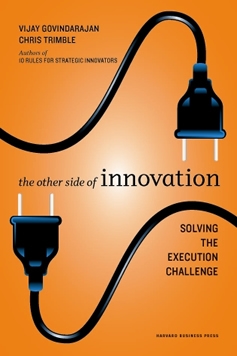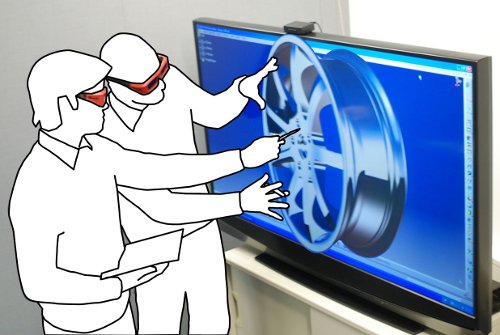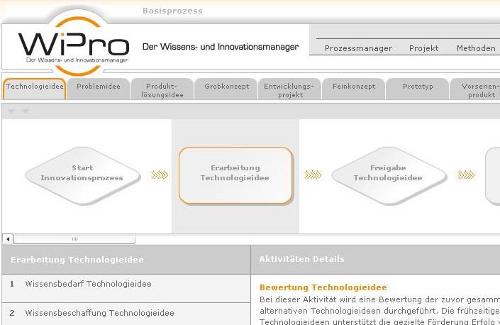V. Govindarajan & C. Trimble 2010: The other side of innovation – solving the execution challenge
 Through the analysis of various industrial cases, the authors extract and describe major recommendations for successful innovation projects. These recommendations are reflected in the chapters of the book and complemented by assessment tools providing critical questions for planning or analysing innovation activities. Providing generally accepted principles of Project, Innovation and R&D Management, the authors underline these with an impressive number of industrial cases and translate these principles into relatively concrete recommendations. The following recommendations create the baseline for the table of content:
Through the analysis of various industrial cases, the authors extract and describe major recommendations for successful innovation projects. These recommendations are reflected in the chapters of the book and complemented by assessment tools providing critical questions for planning or analysing innovation activities. Providing generally accepted principles of Project, Innovation and R&D Management, the authors underline these with an impressive number of industrial cases and translate these principles into relatively concrete recommendations. The following recommendations create the baseline for the table of content:
1) Build the Team
– Divide the labor.
– Assemble the dedicated team.
– Manage the partnership.
2) Run a Disciplined Experiment
– Formalize the experiment.
– Break down the hypothesis.
– Seek the truth.
By providing the underlying case studies on the Internet (theothersideofinnovation), the credibility of the authors can hardly be topped. This book is recommendable for all, who like straightforward messages underlined by numerous (different) industrial examples.
J.M. Morgan & J.K. Liker 2006: The Toyota product development system – integrating people, process, and technology
 Lean development is nowadays a well established method to increase the productivity of R&D departments. Despite some problems in recent times, Toyota still represents the shining example and the reference for any other company using this method. The authors underline the principles of lean development through practical examples from Toyota and the comparison with the U.S. automotive industry. The overall book is based on their recommendations towards successful product development which is reflected in the table of content:
Lean development is nowadays a well established method to increase the productivity of R&D departments. Despite some problems in recent times, Toyota still represents the shining example and the reference for any other company using this method. The authors underline the principles of lean development through practical examples from Toyota and the comparison with the U.S. automotive industry. The overall book is based on their recommendations towards successful product development which is reflected in the table of content:
1) Process Subsystem
– Establish customer-defined value to separate value-added from waste.
– Front-load the product development process to explore alternatives thoroughly.
– Create a leveled product development process flow.
– Utilize rigorous standardization to reduce variation and create flexibility and predictable outcomes.
2) People Subsystem
– Create a chief engineer system to lead development from start to finish.
– Organize to balance functional expertise and cross-functional integration.
– Develop towering technical competence in all engineers.
– Fully integrate suppliers into the product development system.
– Build in learning and continuous improvement.
– Build a culture to support excellence and relentless improvement.
3) Tools and Technology Subsystem
– Adapt technology to fit your people and process.
– Align your organization through simple, visual communication.
– Use powerful tools for standardization and organisational learning.
This book is a great handbook on the principles of lean development including descriptions of various tools and techniques such as value-stream mapping, A3 problem solving and integration mechanisms. It is worth reading for all who want to get inspirational insights on how to improve product development underlined by industrial examples from the manufacturing (automotive) industry.
Recommendations on how to design the organisation and process structure of R&D and Innovation are becoming more and more common in management literature. They can be the source of great inspiration for improvement and are credible due to the link to „real“ industrial case studies. However, the major challenge lies in the identification of the tools and techniques that work in the own company and finally in leading these tools and techniques towards successful implementation.
Sven Schimpf
 Through the analysis of various industrial cases, the authors extract and describe major recommendations for successful innovation projects. These recommendations are reflected in the chapters of the book and complemented by assessment tools providing critical questions for planning or analysing innovation activities. Providing generally accepted principles of Project, Innovation and R&D Management, the authors underline these with an impressive number of industrial cases and translate these principles into relatively concrete recommendations. The following recommendations create the baseline for the table of content:
Through the analysis of various industrial cases, the authors extract and describe major recommendations for successful innovation projects. These recommendations are reflected in the chapters of the book and complemented by assessment tools providing critical questions for planning or analysing innovation activities. Providing generally accepted principles of Project, Innovation and R&D Management, the authors underline these with an impressive number of industrial cases and translate these principles into relatively concrete recommendations. The following recommendations create the baseline for the table of content:
